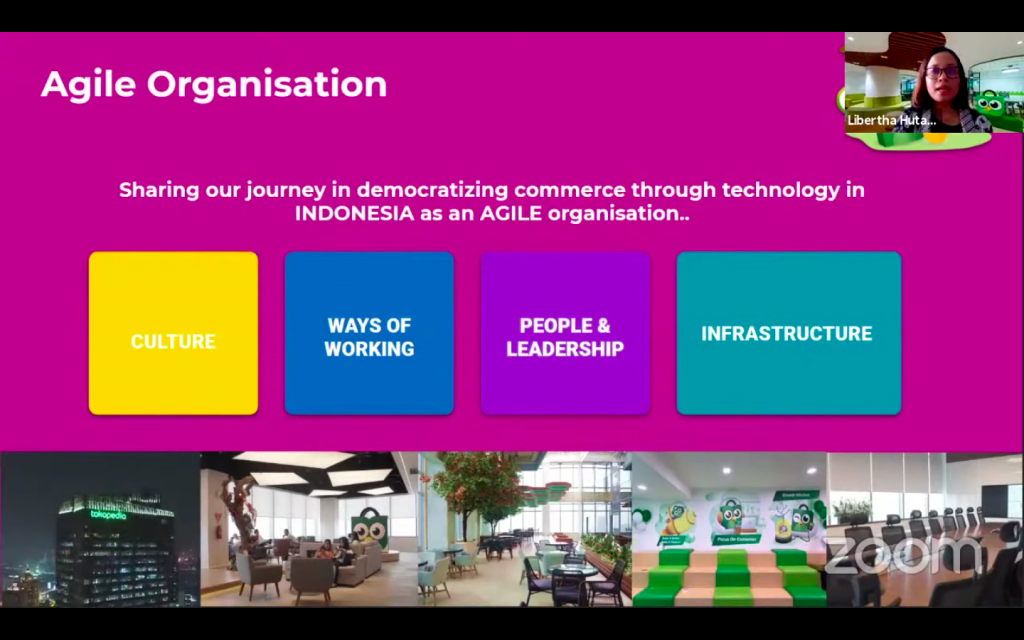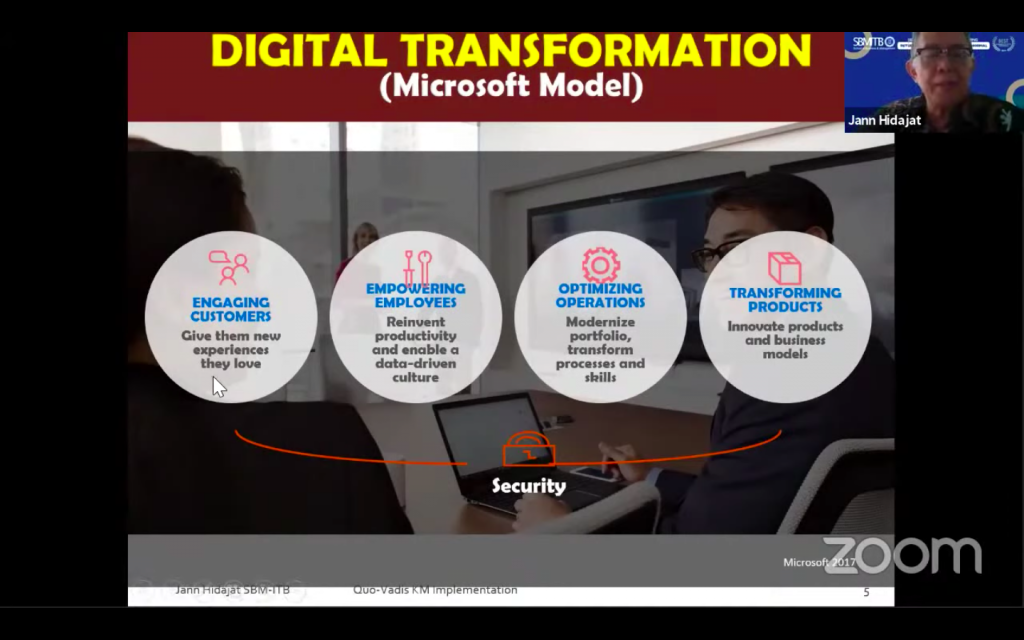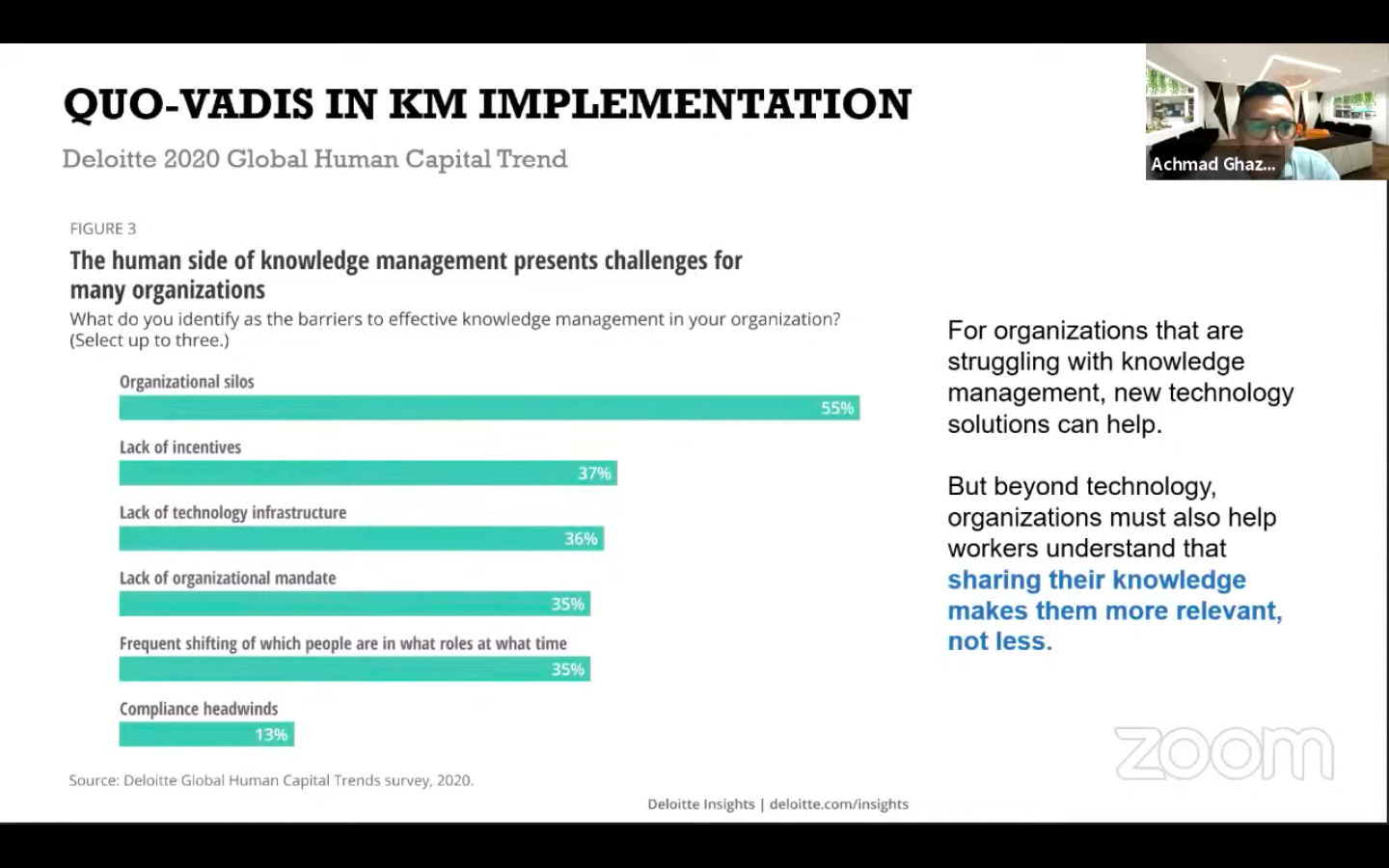Written by Student Reporter Mitsal Athaya, Management 2022)
Knowledge management has been around for nearly 30 years since the idea was first publicly analyzed in the early 90s. Achmad Ghazali, the QA and Accreditation Director at SBM ITB quoted the survey result conducted by Deloitte about Global Human Capital Trend in 2020, “75 percent of surveyed organizations say that creating and preserving knowledge across evolving workforces is important or very important for their success over the next 12-18 months, but only 9% say they are very ready to address this trend,” then added, “this represents one of the largest gaps between importance and readiness across this year’s trend.”
One of the biggest barriers that organizations face to implement knowledge management effectively has been consistent since the 1990s, the organizational silos. “Due to the existence of these silos, decisions tend to take longer to be made and concluded; it hinders the development of knowledge management in organizations,” said Achmad. Apparently, organizational silos believe that knowledge sharing may threaten the organization’s members and convince individuals to understand that sharing knowledge makes them more relevant and not otherwise could be a challenge.
Achmad later emphasized the holistic approach. The training for a holistic business approach requires a couple of team members, but the whole team will be involved instead. To gain success, the whole organization and its condition must be considered. This is only possible if the company’s entire workforce operates at the same pace.
Serafin Talisayon, however, had a different approach to explain knowledge management and agile practices. He chose to tell different stories based on his personal experiences instead of using abstract concepts and joining the sloganeering of ‘agile.’ First, he quoted Andy Hunt, one of the seventeen founders of the Agile Manifesto in 2001, who claimed that the word ‘agile’ has become sloganized, meaningless at best, and jingoist at worst. He stated that the word agile has various meanings, though people have only been doing ‘flaccid agile,’ a half-hearted attempt to follow a few select software development practices poorly.
The agile approach is commonly applied to product development; however, it can also create and capture a new market niche. Serafin stated, “new market niche must be captured quickly, and the development of a unique brand is important in the process of the creation of a niche market.”
Next, he further explained the specialization within a niche market before it becomes congested. As he mentioned previously, it is important to capture a niche market quickly while at the same time developing a unique brand. However, competitors are only nonexistent during the initial time period. As time passes, more competitors will appear as the niche market grows. It is the standardization of services in a market niche — that commoditizes those services — that allow competitors to enter the market. Hence, it is advisable to specialize within the niche market before it becomes too crowded. Serafin illustrates, in this practice, the fact that an unmet need is an opportunity for creativity. He summarized value creation, each with different outcomes, as either market value or social/developmental value, market value leading to more sales and social/developmental value leading to more reputation. He then concluded with an approach that he claims is the most successful agile practice: forming several small, autonomous, and self-driven teams.
Libertha Hutapea, the AVP People Partner and Talent Development of Tokopedia, elaborated on the four aspects that built the foundation of Tokopedia as an e-commerce platform, which includes culture, ways of working, people and leadership, and infrastructure, and how they make Tokopedia an agile organization.

First is culture, she detailed the fact that every company has its own way to interact and collaborate and has its own principles and values which differentiate them from other existing companies. Hence why culture is continuously taught to the people in the company so that the structure is fixed and members of the organization are set on achieving the same goal. Tokopedia implements the performance-and-learning-oriented and rapid iteration and experimentation processes, this aspect falls under the ways of working. The growth mindset that has been established allows the members of Tokopedia to embrace failure and mistakes. The rapid-iteration-and-experimentation process is the manner in which problem-solving and decision-making are to be done in a sprint method. The third is the way in which people collaborate within and outside the organization. Libertha claimed that there exists a complete supporting system for each leader. Furthermore, accountability and decision making are nevertheless clear despite the presence of a large network of teams. Fourth is the infrastructure. Technology has helped track the workforce and the way they do their jobs, according to Libertha. With proper technology in place, by conducting meetings over the Internet instead of at corporate headquarters, executives can save time and money.
Lastly, Jann Hidajat Tjakraatmadja, the Head of People and Knowledge Management Expertise Group and a Professor at SBM ITB, summarized the discussions by stating that knowledge management has different variations but in the end, it all comes to agility.
Digital disruption is redefining many industries. Jann revealed that due to this evolution, many businesses will perish while some may be able to survive. However, more businesses are to come as knowledge becomes more accessible and innovations are to appear alongside the changing needs of the consumers. He used the Microsoft Model to emphasize digital transformation; the measures exercised include engaging customers, empowering employees, optimizing operations, and transforming products.

Ultimately, Jann quoted that it is indeed a challenge to prepare the people in the workforce for digital transformation. It is clear that humans will eventually be replaced by artificial intelligence, but there are a few aspects that these AIs cannot imitate, for instance, creativity, innovation, and human capital. However, “knowledge management will continue to be applicable even during the digital era that is continuously evolving. The development of AIs would not have been possible without the assistance of knowledge management,” he closed.




